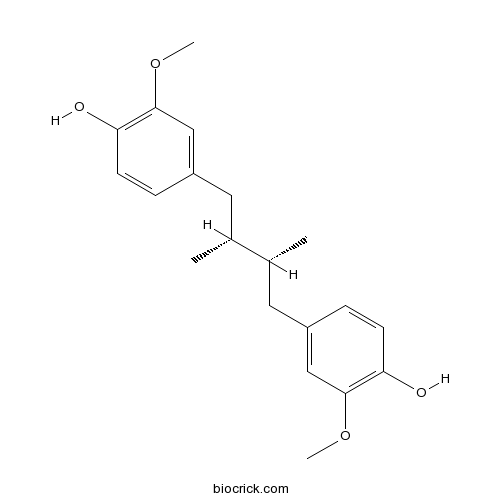(-)-Dihydroguaiaretic acidCAS# 124649-78-1 |

- Dihydroguaiaretic acid
Catalog No.:BCN4212
CAS No.:66322-34-7
Quality Control & MSDS
3D structure
Package In Stock
Number of papers citing our products

| Cas No. | 124649-78-1 | SDF | Download SDF |
| PubChem ID | 11602375 | Appearance | Powder |
| Formula | C20H26O4 | M.Wt | 330.42 |
| Type of Compound | Lignans | Storage | Desiccate at -20°C |
| Solubility | Soluble in Chloroform,Dichloromethane,Ethyl Acetate,DMSO,Acetone,etc. | ||
| Chemical Name | 4-[(2R,3R)-4-(4-hydroxy-3-methoxyphenyl)-2,3-dimethylbutyl]-2-methoxyphenol | ||
| SMILES | CC(CC1=CC(=C(C=C1)O)OC)C(C)CC2=CC(=C(C=C2)O)OC | ||
| Standard InChIKey | ADFOLUXMYYCTRR-ZIAGYGMSSA-N | ||
| Standard InChI | InChI=1S/C20H26O4/c1-13(9-15-5-7-17(21)19(11-15)23-3)14(2)10-16-6-8-18(22)20(12-16)24-4/h5-8,11-14,21-22H,9-10H2,1-4H3/t13-,14-/m1/s1 | ||
| General tips | For obtaining a higher solubility , please warm the tube at 37 ℃ and shake it in the ultrasonic bath for a while.Stock solution can be stored below -20℃ for several months. We recommend that you prepare and use the solution on the same day. However, if the test schedule requires, the stock solutions can be prepared in advance, and the stock solution must be sealed and stored below -20℃. In general, the stock solution can be kept for several months. Before use, we recommend that you leave the vial at room temperature for at least an hour before opening it. |
||
| About Packaging | 1. The packaging of the product may be reversed during transportation, cause the high purity compounds to adhere to the neck or cap of the vial.Take the vail out of its packaging and shake gently until the compounds fall to the bottom of the vial. 2. For liquid products, please centrifuge at 500xg to gather the liquid to the bottom of the vial. 3. Try to avoid loss or contamination during the experiment. |
||
| Shipping Condition | Packaging according to customer requirements(5mg, 10mg, 20mg and more). Ship via FedEx, DHL, UPS, EMS or other couriers with RT, or blue ice upon request. | ||

(-)-Dihydroguaiaretic acid Dilution Calculator

(-)-Dihydroguaiaretic acid Molarity Calculator
| 1 mg | 5 mg | 10 mg | 20 mg | 25 mg | |
| 1 mM | 3.0265 mL | 15.1323 mL | 30.2645 mL | 60.529 mL | 75.6613 mL |
| 5 mM | 0.6053 mL | 3.0265 mL | 6.0529 mL | 12.1058 mL | 15.1323 mL |
| 10 mM | 0.3026 mL | 1.5132 mL | 3.0265 mL | 6.0529 mL | 7.5661 mL |
| 50 mM | 0.0605 mL | 0.3026 mL | 0.6053 mL | 1.2106 mL | 1.5132 mL |
| 100 mM | 0.0303 mL | 0.1513 mL | 0.3026 mL | 0.6053 mL | 0.7566 mL |
| * Note: If you are in the process of experiment, it's necessary to make the dilution ratios of the samples. The dilution data above is only for reference. Normally, it's can get a better solubility within lower of Concentrations. | |||||

Calcutta University

University of Minnesota

University of Maryland School of Medicine

University of Illinois at Chicago

The Ohio State University

University of Zurich

Harvard University

Colorado State University

Auburn University

Yale University

Worcester Polytechnic Institute

Washington State University

Stanford University

University of Leipzig

Universidade da Beira Interior

The Institute of Cancer Research

Heidelberg University

University of Amsterdam

University of Auckland

TsingHua University

The University of Michigan

Miami University

DRURY University

Jilin University

Fudan University

Wuhan University

Sun Yat-sen University

Universite de Paris

Deemed University

Auckland University

The University of Tokyo

Korea University
- Officinaruminane B
Catalog No.:BCN3594
CAS No.:1246282-67-6
- C3bot (154-182)
Catalog No.:BCC6117
CAS No.:1246280-79-4
- VU 0364439
Catalog No.:BCC1239
CAS No.:1246086-78-1
- Methyl (2R,3S)-3-(tert-butoxycarbonylamino)-2-hydroxy-3-phenylpropionate
Catalog No.:BCN8363
CAS No.:124605-42-1
- 4'-O-trans-p-Coumaroylmussaenoside
Catalog No.:BCN6130
CAS No.:1246012-27-0
- 6-O-trans-p-Coumaroylshanzhiside methyl ester
Catalog No.:BCN1597
CAS No.:1246012-26-9
- 6-O-trans-Cinnamoylphlorigidoside B
Catalog No.:BCN6129
CAS No.:1246012-25-8
- 6-O-Benzoylphlorigidoside B
Catalog No.:BCN6128
CAS No.:1246012-24-7
- 2-Methyl-4-(2-methylbutyryl)phloroglucinol
Catalog No.:BCN7175
CAS No.:124598-11-4
- TC-A 2317 hydrochloride
Catalog No.:BCC2418
CAS No.:1245907-03-2
- Daidzin 6'-O-malonate
Catalog No.:BCN8245
CAS No.:124590-31-4
- Brain natriuretic peptide (1-32) (human)
Catalog No.:BCC6034
CAS No.:124584-08-3
- SR1078
Catalog No.:BCC1963
CAS No.:1246525-60-9
- MPI-0479605
Catalog No.:BCC5347
CAS No.:1246529-32-7
- VS-5584 (SB2343)
Catalog No.:BCC2047
CAS No.:1246560-33-7
- 5,7,4'-Trihydroxy-3,6-dimethoxy-3',5'-diprenylflavone
Catalog No.:BCN1596
CAS No.:1246926-08-8
- 5'-Prenylaliarin
Catalog No.:BCN4829
CAS No.:1246926-09-9
- Methyl-Dodovisate A
Catalog No.:BCN4719
CAS No.:1246937-33-6
- Meprednisone
Catalog No.:BCC4893
CAS No.:1247-42-3
- Quinovic acid 3-O-(6-deoxy-beta-D-glucopyranoside) 28-O-beta-D-glucopyranosyl ester
Catalog No.:BCN1595
CAS No.:124727-10-2
- Losartan Potassium (DuP 753)
Catalog No.:BCC1080
CAS No.:124750-99-8
- P 22077
Catalog No.:BCC3616
CAS No.:1247819-59-5
- USP7-USP47 inhibitor
Catalog No.:BCC4113
CAS No.:1247825-37-1
- Valaciclovir
Catalog No.:BCC2025
CAS No.:124832-26-4
Potential Antiosteoporotic Natural Product Lead Compounds That Inhibit 17beta-Hydroxysteroid Dehydrogenase Type 2.[Pubmed:28319389]
J Nat Prod. 2017 Apr 28;80(4):965-974.
17beta-Hydroxysteroid dehydrogenase type 2 (17beta-HSD2) converts the active steroid hormones estradiol, testosterone, and 5alpha-dihydrotestosterone into their weakly active forms estrone, Delta(4)-androstene-3,17-dione, and 5alpha-androstane-3,17-dione, respectively, thereby regulating cell- and tissue-specific steroid action. As reduced levels of active steroids are associated with compromised bone health and onset of osteoporosis, 17beta-HSD2 is considered a target for antiosteoporotic treatment. In this study, a pharmacophore model based on 17beta-HSD2 inhibitors was applied to a virtual screening of various databases containing natural products in order to discover new lead structures from nature. In total, 36 hit molecules were selected for biological evaluation. Of these compounds, 12 inhibited 17beta-HSD2 with nanomolar to low micromolar IC50 values. The most potent compounds, nordihydroguaiaretic acid (1), IC50 0.38 +/- 0.04 muM, (-)-Dihydroguaiaretic acid (4), IC50 0.94 +/- 0.02 muM, isoliquiritigenin (6), IC50 0.36 +/- 0.08 muM, and ethyl vanillate (12), IC50 1.28 +/- 0.26 muM, showed 8-fold or higher selectivity over 17beta-HSD1. As some of the identified compounds belong to the same structural class, structure-activity relationships were derived for these molecules. Thus, this study describes new 17beta-HSD2 inhibitors from nature and provides insights into the binding pocket of 17beta-HSD2, offering a promising starting point for further research in this area.


